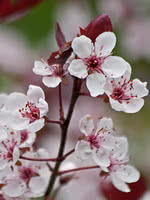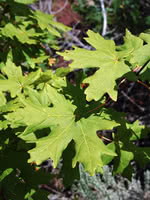Mon-Fri 9am - 5pm Mountain time
Purple Leaf Sand Cherry vs Big Tooth Maple
Prunus x cistena
Acer grandidentatum
CUSTOM GROW
NOT AVAILABLE THIS SEASON - MIGHT RETURN
Purple Leaf Sand Cherry provides bright reddish-purple leaves that turn bronze-green in the fall. In the spring, tiny flowers with a pinkish white hue bloom. The flowers are small, but the impact comes from the shrub blossoming all at once.
The Purple leaf sand cherry can be susceptible to pests and diseases in more humid areas; a typical life span is approximately 15 years. Not suitable for a privacy hedge on its own but is often alternated with lilacs. Often used as an accent plant that attracts birds and bees.
Big Tooth Maple is a versatile, cold hardy maple variety that is ideal for small landscapes. It has high ornamental appeal due to its striking red-gold autumn foliage and multi-stemmed form.
Big Tooth Maple is highly deer resistant and drought tolerant as well. Keep in mind the size and form of this tree can vary due to climate, moisture, and growing conditions. In drier spots, you'll notice Big Tooth Maple is more shrub like. In moist, full sun conditions, this tree can grow to be up to 50 ft tall. Plan your site accordingly.
Purple Leaf Sand Cherry Quick Facts
Big Tooth Maple Quick Facts
Toxicity: the leaves and seed are slightly toxic

